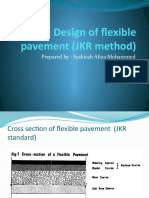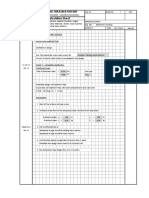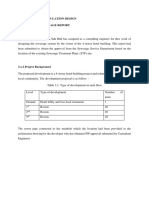MSMA
MSMA
Uploaded by
Matthew WeeCopyright:
Available Formats
MSMA
MSMA
Uploaded by
Matthew WeeOriginal Description:
Copyright
Available Formats
Share this document
Did you find this document useful?
Is this content inappropriate?
Copyright:
Available Formats
MSMA
MSMA
Uploaded by
Matthew WeeCopyright:
Available Formats
APPENDIX DESIGN DATA & REFERENCES
1.0
REFERENCE
1.1
The design is based on the Urban Stormwater Management Manual for Malaysia 2nd Edition from
Department of Irrigation and Drainage (DID) Malaysia hereinafter referred to as MSMA. The
following formulas and tables are used in the design report.
2.0
DESIGN CONSIDERATION AND CRITERIA
2.1
Table 12.16: Sediment Basin Types and Design Considerations, MSMA 2nd Edition.
Category
2.2
Soil Description
Hydrological
Soil Group
Basin
Type
Design Considerations
Coarse-grained sand, sandy loam: less
than 33% <0.02 mm
Dry
Settling velocity,
sediment storage
II
Fine-grained loam, clay: more than 33% <
0.02 mm
Wet
Storm impoundment,
sediment storage
III
Dispersible fine-grained clays: more than
10% of dispersible material
C, D
Wet
Storm impoundment,
sediment storage,
assisted flocculation
Table 12.17: Design Criteria of Sediment Basin for Sediment Control, MSMA 2nd Edition.
Parameter
Basin Type Refer
Runoff Quantity Design
Runoff Quality Design
Runoff Control
Flood Protection
Minimum Contributing Area
Storage Volume
Basin Dimension
Embankment
Erosion Protection
Sediment Trapping
Maintenance Frequency
Requirement
Table 12.16
Up to 10-years ARI
First 50 mm rainfall over contributing (equivalent impervious)
Catchment
All flow up to runoff quality design shall be retained within the
trap
The basin should drain within 24 hours (dry)/ 36 hours (wet)
after the water quality design storm.
The primary outlet/riser should be used to control storm water
runoff.
The Emergency spillway should safely conveying flows up to
10 year ARI
Ensure that upstream/ downstream flooding conditions do not
aggravate possible failure of the embankment.
2 ha
Total Storage: Refer Table 12.18 (dry) or Table 12.19 (wet)
Settling zone volume: half of total storage
Sediment zone volume: half of total storage
Minimum length to width ratio: 2:1
Maximum length to settling depth ratio: 200:1
Minimum settling zone depth: 0.6 m
Minimum sediment storage zone depth: 0.3 m
Side slope: (2(H):1(V) or flatter
Outlet protection shall be provided for the emergency spillway
90% of Total Suspended Solids Removal
Determined by dividing sediment storage capacity by the amount
of sediment collected in a water quality design storm
APPENDIX DESIGN DATA & REFERENCES
2.3
Table 12.18: Dry Sediment Basin Sizing Criteria, MSMA 2nd Edition.
Parameter
Surface Area (m2/ha
Total Volume (m3/ha)
2.4
Time of Concentration of Basin Catchment (minutes)
10
20
30
45
60
333
250
200
158
121
400
300
240
190
145
Table 12.19: Wet Sediment Basin Sizing Volume (m3/ha) , MSMA 2nd Edition.
Parameter
Settling Zone Volume
Total Volume
Site Runoff Potential
Moderate to high runoff
Very high runoff
Moderate to high runoff
Very high runoff
Magnitude of Design Storm Event (mm)
20
30
40
50
60
70
127
200
290
380
100
167
260
340
440
105
190
300
435
570
150
250
390
510
660
3.0
TIME OF CONCENTRATION
3.1
Overland flow time is estimated by the use of Friends Equation (Table 2.1, MSMA 2nd Edition).
Typical values of Hortons roughness n* for various land surfaces are taken from Table 2.2, MSMA
2nd Edition.
Table 2.1: Equations to Estimate Time of Concentration (QUDM, 2007), MSMA 2nd Edition
Travel Path
Overland Flow
Curb Gutter Flow
Drain Flow
Travel Time
Remark
to = Overland sheet flow travel time (minutes)
L = Overland sheet flow path length (m)
for Steep Slope (>10%), L 50 m
for Moderate Slope (<5%), L 100 m
for Mild Slope (<1%), L 200 m
n* = Hortons roughness value for the surface (Table 2.2)
S = Slope of overland surface (%)
tg = Curb gutter flow time (minutes)
L = Length of curb gutter flow (m)
S = Longitudinal slope of the curb gutter (%)
n = Mannings roughness coefficient (Table 2.3)
R = Hydraulic radius (m)
S = Friction slope (m/m)
L = Length of reach (m)
td = Travel time in the drain (minutes)
Table 2.2: Values of Hortons Roughness n* (QUDM, 2007), MSMA 2nd Edition
Land Surface
Paved
Bare Soil
Poorly Grassed
Average Grassed
Hortons Roughness n*
0.015
0.0275
0.035
0.045
APPENDIX DESIGN DATA & REFERENCES
Densely Grassed
0.060
4.0
DESIGN RAINFALL INTENSITY
4.1
Adopted from Hydrological Procedure (HP) No. 1 revised in 2010 expressed in Equation 2.2, MSMA
2nd Edition:
where,
i
T
d
, K, ,
= average rainfall intensity (mm/hr)
= average recurrence interval ARI (0.5 T 12 months & 2 T 100 years)
= storm duration (hours), 0.0833 d 72
= fitting constants dependent on the raingauge location (Table 2.B1 in Appendix 2.B)
5.0
STAGE DISCHARGE RELATIONSHIP
5.1
For a single orifice, orifice flow is estimated by the use of Equation 2.6, MSMA 2nd Edition.
Q = Co Ao (2gHo)0.5
where,
Q
Co
Ao
Ho
G
= orifice flow rate (m3/s)
= discharge coefficient (0.60)
= x-sectional area of orifice (m2)
= effective head of the orifice measured from the centroid of the opening (m)
= gravitational acceleration (9.81 m/s2)
If orifice discharges as a free outfall, effective head is measured from the centerline of the orifice to the
upstream water surface elevation
If orifice discharge is submerged, effective head is the difference in elevation of the upstream and
downstream water surfaces.
5.2
Broad-crested emergency spillway flow is estimated by the use of Equation 2.10, MSMA 2nd Edition.
where,
Q
CSP
B
Hp
= emergency spillway discharge (m3/s)
= spillway discharge coefficient (m0.5/s)
= spillway base width (m)
= effective head on the spillway weir crest (m)
The discharge coefficient CSP in Equation 2.10 varies as a function of spillway base width and
effective head (Table 2.7).
APPENDIX DESIGN DATA & REFERENCES
Table 2.7: Broad-Crested Weir Coefficient CSP Values as a Function of Weir Base Width and Head
(FHWA, 1996), MSMA 2nd Edition
Head
Hp (m)
0.10
0.15
0.20
0.30
0.40
0.50
0.60
0.70
0.80
0.90
1.00
1.10
1.20
1.30
1.40
1.50
1.60
0.15
1.59
1.65
1.73
1.83
1.83
1.83
1.83
1.83
1.83
1.83
1.83
1.83
1.83
1.83
1.83
1.83
1.83
0.20
1.56
1.60
1.66
1.77
1.80
1.82
1.83
1.83
1.83
1.83
1.83
1.83
1.83
1.83
1.83
1.83
1.83
0.30
1.50
1.51
1.54
1.64
1.74
1.81
1.82
1.83
1.83
1.83
1.83
1.83
1.83
1.83
1.83
1.83
1.83
0.40
1.47
1.48
1.49
1.56
1.65
1.74
1.73
1.78
1.82
1.83
1.83
1.83
1.83
1.83
1.83
1.83
1.83
0.50
1.45
1.45
1.46
1.50
1.57
1.67
1.65
1.72
1.79
1.81
1.82
1.83
1.83
1.83
1.83
1.83
1.83
Weir Base Width B (m)
0.60 0.70 0.80 0.90 1.00
1.43 1.42 1.41 1.40 1.39
1.44 1.44 1.44 1.45 1.45
1.44 1.44 1.45 1.46 1.48
1.47 1.46 1.46 1.46 1.47
1.52 1.49 1.47 1.46 1.46
1.60 1.55 1.51 1.48 1.48
1.58 1.54 1.46 1.31 1.34
1.65 1.60 1.53 1.44 1.45
1.72 1.66 1.60 1.57 1.55
1.76 1.71 1.66 1.61 1.58
1.81 1.76 1.70 1.64 1.60
1.83 1.80 1.75 1.66 1.62
1.83 1.83 1.79 1.70 1.65
1.83 1.83 1.82 1.77 1.71
1.83 1.83 1.83 1.83 1.77
1.83 1.83 1.83 1.83 1.79
1.83 1.83 1.83 1.83 1.81
1.25
1.37
1.44
1.48
1.47
1.47
1.47
1.48
1.49
1.50
1.50
1.51
1.52
1.53
1.56
1.60
1.66
1.74
1.50
1.35
1.43
1.49
1.48
1.47
1.46
1.46
1.47
1.47
1.47
1.48
1.49
1.49
1.51
1.52
1.55
1.58
2.00
1.36
1.44
1.49
1.48
1.47
1.46
1.46
1.47
1.47
1.47
1.47
1.47
1.48
1.49
1.50
1.51
1.53
3.00
1.40
1.45
1.49
1.48
1.48
1.46
1.46
1.46
1.46
1.46
1.46
1.46
1.46
1.46
1.46
1.46
1.46
4.00
1.45
1.45
1.45
1.45
1.45
1.45
1.45
1.45
1.45
1.45
1.45
1.45
1.45
1.45
1.45
1.45
1.45
You might also like
- Sewer Design CalculationDocument2 pagesSewer Design CalculationMatthew Wee94% (16)
- Technical Guide No.1 Estimation of Future Design Rainstorm Under The Climate Change Scenario in Peninsular MalaysiaDocument28 pagesTechnical Guide No.1 Estimation of Future Design Rainstorm Under The Climate Change Scenario in Peninsular MalaysiaNina AzizNo ratings yet
- Chapter 4 Time Value of Money (Part 2b) 2020Document36 pagesChapter 4 Time Value of Money (Part 2b) 2020Nur HazwaniNo ratings yet
- Chap 6 - Final Design Component - AllDocument44 pagesChap 6 - Final Design Component - AllSiti Rosila Bt BaharinNo ratings yet
- Drainage Urban Design-Full ReportDocument51 pagesDrainage Urban Design-Full ReportNORTASHA ZULAIKA MOHD KHALILNo ratings yet
- T2Document6 pagesT2Anzai HikariNo ratings yet
- Msma PDFDocument100 pagesMsma PDFMimi Aireen Harmira HassimNo ratings yet
- AppendixDocument6 pagesAppendixAidaFarzanaNanaNo ratings yet
- Project Hydraulics and HydrologyDocument17 pagesProject Hydraulics and HydrologyEiyra NadiaNo ratings yet
- Culvert: Building Today Creating TomorrowDocument20 pagesCulvert: Building Today Creating Tomorrowmya umairahNo ratings yet
- Design of Water Reticulation Part1Document33 pagesDesign of Water Reticulation Part1MuhammadSallehNo ratings yet
- DR Quek Time Area KL - MSMA2Document5 pagesDR Quek Time Area KL - MSMA2Wan MahiramNo ratings yet
- Group 3 - 06 - Water ReticulationDocument27 pagesGroup 3 - 06 - Water Reticulationrhaqim41No ratings yet
- MASMA OSD BANDAR RASA (LOT 10093) - CompressedDocument16 pagesMASMA OSD BANDAR RASA (LOT 10093) - CompressedImran37AfiqNo ratings yet
- Rational Method For MSMA 2nd EdDocument38 pagesRational Method For MSMA 2nd Eddanis nyaNo ratings yet
- Sediment Basin ExampleDocument8 pagesSediment Basin ExampleastarnasNo ratings yet
- Design of Flexible Pavement (JKR Method)Document10 pagesDesign of Flexible Pavement (JKR Method)B.A HNo ratings yet
- Rational Method Computation Time 30mins: Infravera SDN BHDDocument10 pagesRational Method Computation Time 30mins: Infravera SDN BHDazhar ahmadNo ratings yet
- Test 1 BFC 32002 Hydrology - 1314 PDFDocument9 pagesTest 1 BFC 32002 Hydrology - 1314 PDFAzfarNo ratings yet
- Project SKAA2722-20162017-2 Geoteknik 1Document16 pagesProject SKAA2722-20162017-2 Geoteknik 1Haryati Baharuddin50% (2)
- Idp 1 - S4 - G3 New Full ReportDocument18 pagesIdp 1 - S4 - G3 New Full ReportdhazliNo ratings yet
- Drainage ReportDocument4 pagesDrainage ReportmemeyumieNo ratings yet
- Elegent Co Sewerage NewDocument3 pagesElegent Co Sewerage NewLuqmannul HaqimNo ratings yet
- Quality Design Fundamental in MSMADocument14 pagesQuality Design Fundamental in MSMANur Farhana Ahmad FuadNo ratings yet
- Project Report Topic: Analysis of Statically Determinate BeamDocument22 pagesProject Report Topic: Analysis of Statically Determinate BeamMARVINNo ratings yet
- Calculation Sheet: Perunding Nusajasa SDN BHDDocument7 pagesCalculation Sheet: Perunding Nusajasa SDN BHDSarahLukakuNo ratings yet
- Development of Unsignalised Intersection Analysis Procedure For The Malaysian Highway Capacity Manual PDFDocument45 pagesDevelopment of Unsignalised Intersection Analysis Procedure For The Malaysian Highway Capacity Manual PDFNizam MohamadNo ratings yet
- EC 11SlopeDrainsDocument6 pagesEC 11SlopeDrainstsuakNo ratings yet
- Major Drain Reference Calculation Output All Reference Is Manual Saliranmesraalam (Msma 2 Edition)Document2 pagesMajor Drain Reference Calculation Output All Reference Is Manual Saliranmesraalam (Msma 2 Edition)mya umairahNo ratings yet
- Complete Report - SewerageDocument8 pagesComplete Report - SewerageBatrisyialya Rusli100% (1)
- Comparison Between Esteem & ManualDocument12 pagesComparison Between Esteem & ManualalialiNo ratings yet
- Idp Sewerage ReportDocument15 pagesIdp Sewerage Reporthajjiyare2016No ratings yet
- Arahan Teknik 8-86 R3Document1 pageArahan Teknik 8-86 R3Pipi KNo ratings yet
- Rpp04 Idp Bfc43303 - Laterst02-01Document6 pagesRpp04 Idp Bfc43303 - Laterst02-01Syamim BakriNo ratings yet
- ECG524-Topic 2a-Asphaltic Concrete Pavement DesignDocument68 pagesECG524-Topic 2a-Asphaltic Concrete Pavement DesignAdika Azwan100% (1)
- Design of Drainage System Based On Masma: Integrated Design Project - Idp (Ecm506) BY Ir - Basir NoordinDocument100 pagesDesign of Drainage System Based On Masma: Integrated Design Project - Idp (Ecm506) BY Ir - Basir NoordinNurul Fatihah SyazwaniNo ratings yet
- Sewarage Report Final PDFDocument10 pagesSewarage Report Final PDFFILZAH HASHMINo ratings yet
- Buku Rujukan Ringkas - Routine Maintenance Work Activities-ScribdDocument10 pagesBuku Rujukan Ringkas - Routine Maintenance Work Activities-ScribdSITI KHADIJAH BINTI OTHMAN (JKR)No ratings yet
- Road DesignDocument2 pagesRoad DesignezzatyNo ratings yet
- NusajayaDocument122 pagesNusajayaHafizah MohdNo ratings yet
- 1.0 - 1.1 - Project Brief: (2.5 X Average Flow)Document11 pages1.0 - 1.1 - Project Brief: (2.5 X Average Flow)Siongyung KongNo ratings yet
- DBKL ChecklistDocument4 pagesDBKL ChecklistJia Fei KuangNo ratings yet
- Individual Assignment BFC 32403 Sem 2 20192020Document18 pagesIndividual Assignment BFC 32403 Sem 2 20192020abood buriahiNo ratings yet
- Pavement Condition IndexDocument29 pagesPavement Condition IndexAliff HaikalNo ratings yet
- Report PCIDocument28 pagesReport PCIKimaii ZakiNo ratings yet
- Perunding Yaa Sdn. BHD.: Hydraulic Calculation Report (On Site Detention)Document3 pagesPerunding Yaa Sdn. BHD.: Hydraulic Calculation Report (On Site Detention)Fendy Royn100% (2)
- Group 3 (Seksyen4)Document15 pagesGroup 3 (Seksyen4)alnzNo ratings yet
- Final Report - Ecc589 - Educational TalkDocument31 pagesFinal Report - Ecc589 - Educational TalkAmreen ShahNo ratings yet
- Minor Drain All Reference Is Manual Saliranmesraalam (Msma 2 Edition)Document4 pagesMinor Drain All Reference Is Manual Saliranmesraalam (Msma 2 Edition)mya umairah100% (2)
- Testbfc31802sem-1-2021-2022-Question (1) (Soalan Test 2021)Document12 pagesTestbfc31802sem-1-2021-2022-Question (1) (Soalan Test 2021)Amirul AdzinNo ratings yet
- Detention Pond 1Document97 pagesDetention Pond 1عصام السامرائي100% (1)
- Esteem 9 Roof Beam ResultDocument6 pagesEsteem 9 Roof Beam Resultmysteryman2960No ratings yet
- Group 3 04 DrainageDocument58 pagesGroup 3 04 Drainagerhaqim41No ratings yet
- FULL EXP 3.5 Capacity Analysis On Signalized IntersectionDocument10 pagesFULL EXP 3.5 Capacity Analysis On Signalized IntersectionAzyan Afiqah100% (1)
- Drainage Design CriteriaDocument16 pagesDrainage Design CriteriaKS Lee100% (2)
- Eat238 - Intro MsmaDocument32 pagesEat238 - Intro MsmaYazid NazriNo ratings yet
- OSD UndergroundDocument14 pagesOSD UndergroundMohamad Zahir RazakNo ratings yet
- History of Civil EngineeringDocument3 pagesHistory of Civil EngineeringkhajaimadNo ratings yet
- Grraded Soil Bund PDFDocument5 pagesGrraded Soil Bund PDFtekleboltana74No ratings yet
- Urban DrainageDocument98 pagesUrban DrainagemrlobboNo ratings yet
- Lecture 5 - Planning and Design of SewerDocument14 pagesLecture 5 - Planning and Design of SewerDamn sonNo ratings yet
- Water RecDocument2 pagesWater RecMatthew WeeNo ratings yet
- Pe ComputationDocument1 pagePe ComputationMatthew WeeNo ratings yet
- Sample Calc SEWERDocument2 pagesSample Calc SEWERMatthew WeeNo ratings yet
- Water ReportDocument3 pagesWater ReportMatthew WeeNo ratings yet
- Code of EthicsDocument14 pagesCode of EthicsMatthew WeeNo ratings yet
- BS en Standard Code ListDocument64 pagesBS en Standard Code Listtimoss7475% (4)
- Form SWA-LRDocument8 pagesForm SWA-LRMatthew WeeNo ratings yet
- Code of Ethics: Fundamental PrinciplesDocument1 pageCode of Ethics: Fundamental PrinciplesMatthew WeeNo ratings yet
- Pipe (Q10)Document2 pagesPipe (Q10)Matthew WeeNo ratings yet
- MSMADocument4 pagesMSMAMatthew WeeNo ratings yet
- Pipe (Q10)Document2 pagesPipe (Q10)Matthew WeeNo ratings yet
- Road SafetyDocument65 pagesRoad SafetyMatthew Wee100% (1)
- Appreciation of Loads and Truss DesignDocument22 pagesAppreciation of Loads and Truss DesignMatthew Wee100% (2)
- SaleDocument1 pageSaleMatthew WeeNo ratings yet









































































